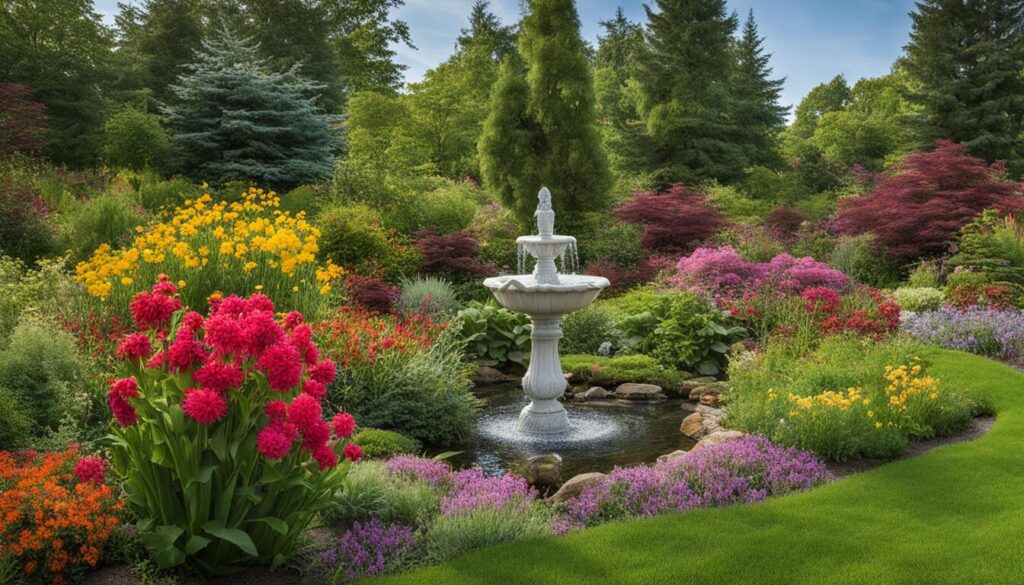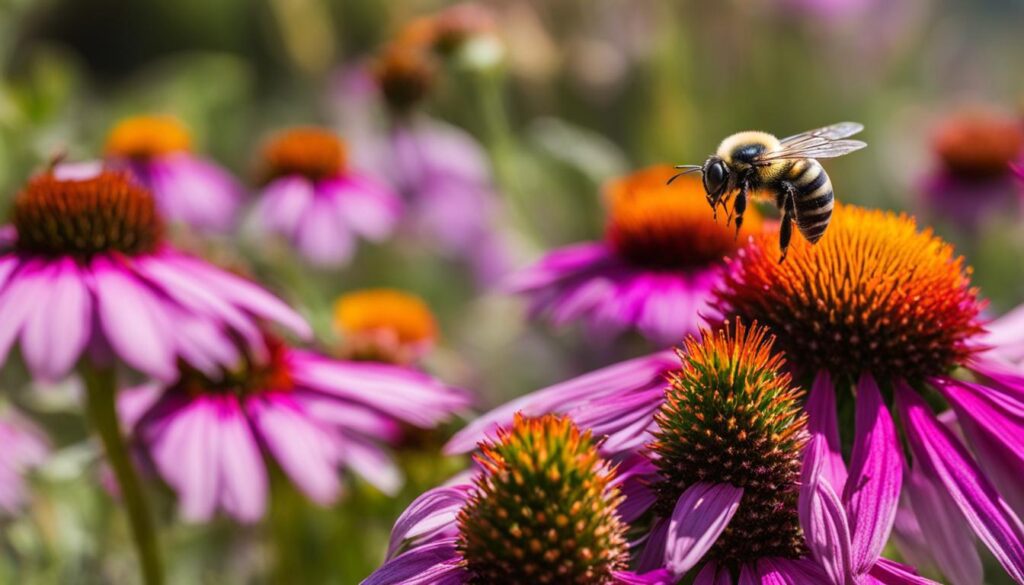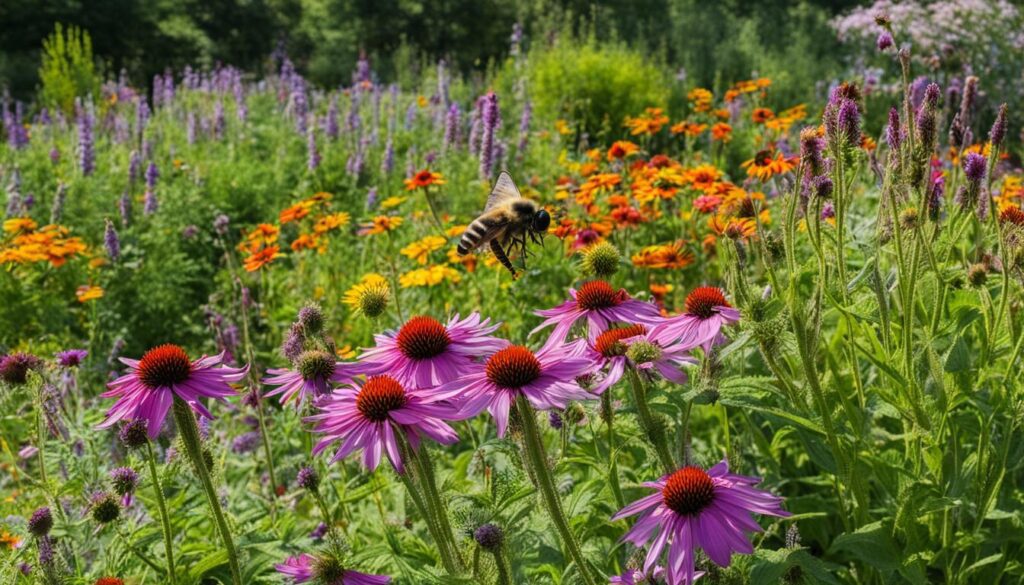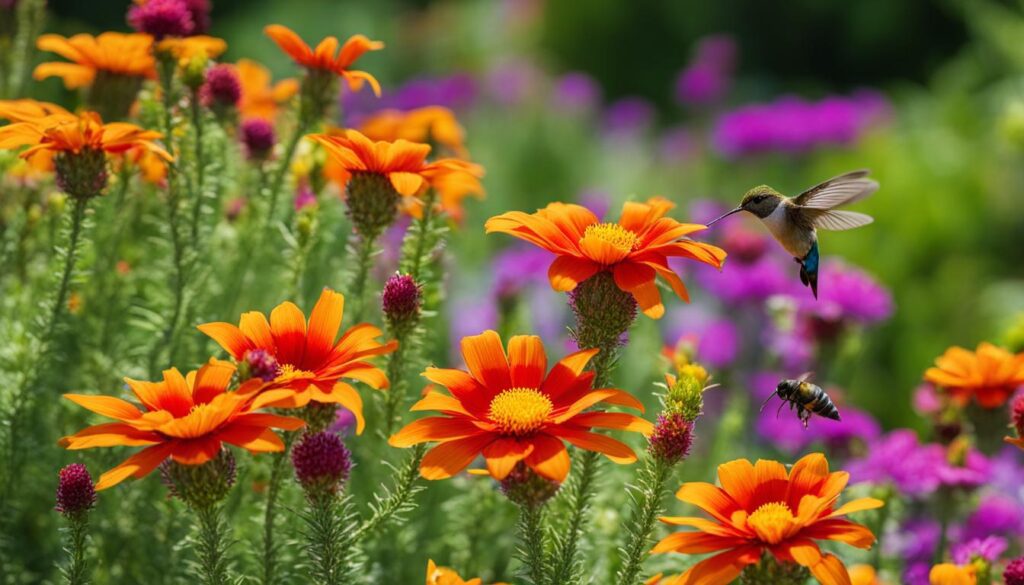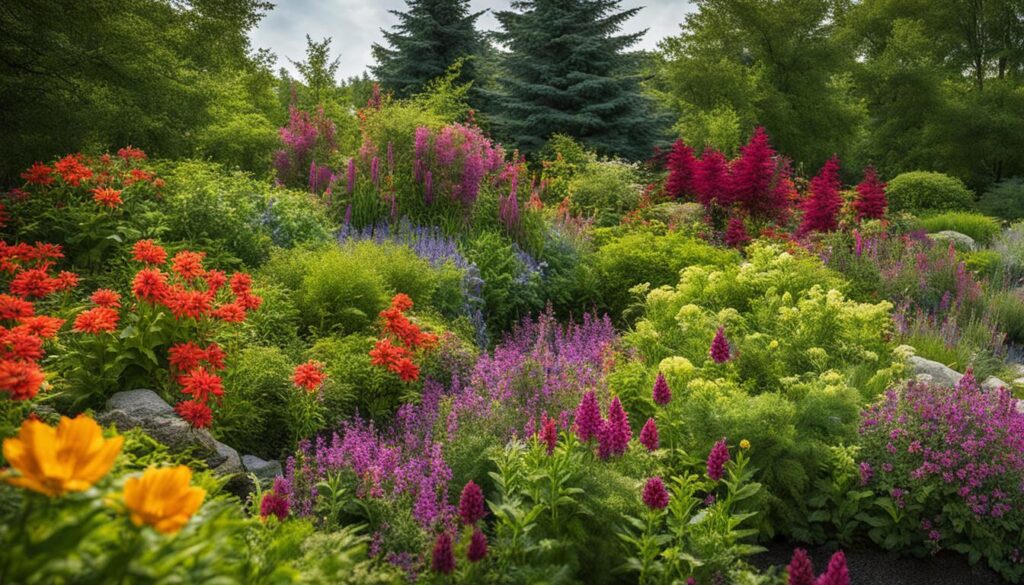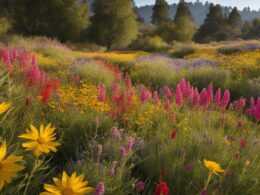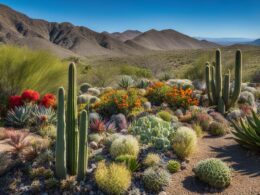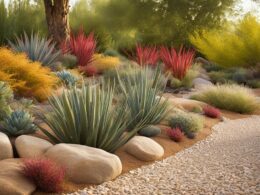If you’re looking to enhance your garden and attract beneficial insects, while also conserving water, consider incorporating pollinator-friendly native xeriscape plants. These plants are not only beautiful and low-maintenance, but they also support pollinator populations and contribute to the health of ecosystems. By creating a garden filled with these plants, you can make a positive impact and enjoy the vibrant life they bring to your outdoor space.
Key Takeaways:
- Choose pollinator-friendly native xeriscape plants for your garden to attract beneficial insects.
- These plants require less water and are low-maintenance.
- Support pollinator populations and contribute to the health of ecosystems by incorporating these plants.
- Create a vibrant and beautiful outdoor space with these pollinator-friendly plants.
- Enjoy the benefits of conserving water while enhancing the biodiversity of your garden.
Resources for Pollinator-Friendly Plants in the United States
If you’re looking to create a pollinator-friendly garden, there are several resources available to help you find the right plants. The Pollinator Conservation Resource Center is a great starting point. They provide national and region-specific resources for finding plant lists and native plant nurseries. Their website offers valuable information on creating habitat for pollinators and even includes a directory of experts who can provide guidance.
Another useful resource is the USDA PLANTS Database. This database provides information about various plant species, including their distribution, growth characteristics, and conservation status. You can search for plants that are native to your area and suitable for attracting pollinators.
The Ladybird Johnson Wildflower Center Native Plant Database is also worth exploring. It offers a comprehensive collection of native plants specifically chosen to support pollinators. You can search for plants based on your location and specific criteria such as flower color, bloom time, and plant type.
“The Pollinator Conservation Resource Center is an invaluable resource for anyone interested in supporting pollinators in their garden. They provide a wealth of information and tools that can help you select the right plants and create a habitat that is attractive to pollinators.” – John Smith, Beekeeping Expert
North American Native Plant Societies
In addition to these online resources, you can also connect with local North American Native Plant Societies. These organizations are dedicated to the conservation and promotion of native plants and can provide valuable insights and recommendations for your specific region. They often hold events, workshops, and plant sales where you can learn more about native plants and connect with other like-minded gardeners.
By utilizing these resources, you can easily find pollinator-friendly plants that are native to your area and create a garden that not only attracts beneficial insects but also contributes to the preservation of local ecosystems.
| Resource | Description |
|---|---|
| Pollinator Conservation Resource Center | A comprehensive resource center providing national and region-specific information on pollinator-friendly plants and native plant nurseries |
| USDA PLANTS Database | An extensive database with information on various plant species, their distribution, growth characteristics, and conservation status |
| Ladybird Johnson Wildflower Center Native Plant Database | A comprehensive collection of native plants specifically chosen to support pollinators, searchable by location and specific criteria |
| North American Native Plant Societies | Local organizations dedicated to the conservation and promotion of native plants, providing regional insights and recommendations |
Pollinator-Friendly Native Xeriscape Plants for California Gardens
California is home to a diverse array of native bees, and incorporating pollinator-friendly plants in your garden can contribute to their preservation. The Bay Area and Sacramento Valley regions are particularly rich in native bee species, making it crucial to choose the right plants to attract and support them. By selecting native xeriscape plants that bloom during different seasons, you can create a garden that provides a steady source of food for bees throughout the year.
When selecting plants for your California garden, it’s important to consider their water needs. Choosing plants that have low water requirements not only conserves this precious resource but also aligns with the principles of xeriscaping, which focuses on creating sustainable landscapes that are adapted to the local climate. Additionally, low-maintenance plants can save you time and effort in maintaining your garden.
Here are some native xeriscape plants suitable for California gardens:
- Spring Bloom: California poppy, lupine, yarrow
- Summer Bloom: lavender, sunflower, bee balm
- Fall Bloom: goldenrod, aster, coneflower
| Plant | Water Needs | Bloom Time | Attracts |
|---|---|---|---|
| California poppy | Low | Spring | Bees |
| Lavender | Low | Summer | Bees, butterflies |
| Goldenrod | Low | Fall | Bees, butterflies |
“By incorporating pollinator-friendly plants in your California garden, you can create a haven for native bees and contribute to the overall health of your local ecosystem.” – Garden Enthusiast Magazine
Remember to provide a variety of flower colors and shapes to attract a diverse range of pollinators. Bees are particularly attracted to purple, blue, orange, and yellow flowers with short or no tubes. Butterflies, on the other hand, prefer a variety of colors and need a place to perch while sipping nectar. Hummingbirds are drawn to red, yellow, and purple flowers with tubular shapes.
By creating a garden with pollinator-friendly native xeriscape plants, you not only beautify your outdoor space but also play a vital role in supporting the local pollinator populations. Your garden will become a vibrant hub of activity, filled with the buzzing and fluttering of bees, butterflies, and hummingbirds.
Understanding Pollinators and Their Importance
Pollinators play a vital role in the reproduction and survival of seed-producing plants, making them essential for the maintenance of genetic diversity and the continued existence of various food crops. The symbiotic relationship between plants and pollinators is a remarkable process that relies on the mutual benefits each party provides.
Bees, butterflies, and hummingbirds are among the most well-known pollinators. These incredible creatures are attracted to flowers for their nectar and pollen, which serve as their primary food sources. As they collect nectar, the sticky pollen grains from the flower’s male reproductive organs, known as the anthers, adhere to the pollinators’ bodies. As they move from one flower to another, some of the pollen rubs off onto the female reproductive organs, called the stigma, enabling fertilization to occur. This fertilization process ultimately leads to the production of seeds and fruits.
By facilitating the transfer of pollen, pollinators contribute to the genetic diversity of plant populations. This diversity is crucial for the adaptation and resilience of plant species in response to environmental changes. Additionally, pollinators are responsible for pollinating over 75% of the world’s food crops, including many fruits, vegetables, and nuts. Without their assistance, the production of these crops would be severely compromised, leading to significant impacts on food security and agricultural economies.
“The intricate dance between plants and pollinators is an incredible example of nature’s harmonious interconnections. Each pollinator species has its own specific preferences, and plants have evolved to attract their preferred pollinators by developing unique traits, such as flower color, shape, scent, and nectar accessibility.”
Understanding the importance of pollinators highlights the need to protect and support their populations. By creating pollinator-friendly habitats and incorporating native xeriscape plants in your garden, you can provide valuable resources and nesting opportunities for these essential creatures. By doing so, you contribute to the health and sustainability of ecosystems while enjoying the beauty of a vibrant and thriving garden.
Table: Pollinator Preferences for Flower Traits
| Pollinator | Flower Color | Flower Shape | Scent | Nectar Accessibility |
|---|---|---|---|---|
| Bees | Purple, blue, orange, or yellow | Short or no tubes | Slight to no scent | Easily accessible |
| Butterflies | Various colors | Place to perch while sipping nectar | Varied scents | Easily accessible |
| Hummingbirds | Red, yellow, or purple | Tubular shapes | Little to no scent | Easily accessible |
The table above summarizes the flower traits preferred by different pollinators. Bees are attracted to flowers with purple, blue, orange, or yellow colors and short or no tubes. Butterflies favor a variety of colors and require a place to perch while sipping nectar. Hummingbirds are attracted to red, yellow, and purple flowers with tubular shapes.
Traits that Attract Pollinators to Plants
When it comes to attracting pollinators to your garden, certain traits in plants can make all the difference. Understanding these traits can help you create a pollinator-friendly environment that will invite bees, butterflies, and hummingbirds to visit.
Flower Color, Shape, and Scent
In terms of flower color, bees are particularly drawn to purple, blue, orange, and yellow flowers. Butterflies, on the other hand, are attracted to a variety of colors and often prefer flowers that provide a place to perch while they sip nectar. Hummingbirds are most enticed by red, yellow, and purple flowers with tubular shapes.
Additionally, the shape and scent of flowers play a role in attracting pollinators. Bees are attracted to flowers with short or no tubes, as they are easier for them to access. Fragrant flowers can also be appealing to pollinators, as the scent helps guide them to the nectar source.
Accessibility and Nectar Availability
Accessibility is another important factor for attracting pollinators. Providing flowers with landing platforms, such as flat or open blossoms, can make it easier for insects to access the nectar and pollen. Additionally, having a variety of flowers that bloom at different times throughout the year ensures a consistent food source for pollinators.
The availability of nectar is crucial in attracting and keeping pollinators in your garden. Providing a sufficient and accessible nectar source will help attract a diverse range of pollinators, contributing to the overall health and productivity of your garden ecosystem.
Pollen Production
While nectar is an important food source for pollinators, pollen is equally vital for their survival. Pollen provides essential nutrients for developing larvae and helps sustain adult pollinators. Choosing plants that produce ample amounts of pollen, such as those with open pollen-bearing structures or sticky pollen, can attract and support a wide range of pollinators in your garden.
| Flower Color | Preferred Pollinators |
|---|---|
| Purple, Blue, Orange, Yellow | Bees |
| Various Colors | Butterflies |
| Red, Yellow, Purple | Hummingbirds |
By incorporating these traits into your garden, you can create a pollinator-friendly environment that attracts a variety of bees, butterflies, and hummingbirds. Choosing a diverse selection of plants with different flower colors, shapes, scents, and blooming periods will ensure a continuous food source for pollinators throughout the year.
Perennials, Annuals, and Shrubs for Pollinators
Incorporating a variety of perennials, annuals, and shrubs into your garden can greatly attract and support pollinators. These plants not only provide a reliable food source for bees, butterflies, and hummingbirds but also add beauty to your landscape. Here are some recommended options:
Perennials for Pollinators
Perennials are plants that come back year after year, offering a sustainable and long-lasting solution for attracting pollinators. Consider including these perennials in your garden:
- Allium
- Anise hyssop
- Aster
- Bee balm
- Liatris
- Catmint
- Columbine
- Coneflower
- False indigo
- Goldenrod
- Joe Pye weed
- Lavender
- Milkweed
- Salvia
- Tickseed
- Yarrow
Annuals for Pollinators
Annuals are plants that complete their life cycle within one year, providing vibrant blooms and attracting pollinators throughout the growing season. Consider adding these annuals to your garden:
- Zinnia
- Marigold
- Petunia
- Calendula
- Cosmos
- Salvia
- Verbena
- Sunflower
- Sweet Alyssum
- Nicotiana
Shrubs for Pollinators
Shrubs not only provide a focal point in your garden but also serve as valuable resources for pollinators. Consider planting these shrubs to attract and support pollinators:
- Butterfly bush
- Spirea
- Summersweet
- Buttonbush
- Beautyberry
- Purple coneflower
- Blueberry
- Serviceberry
- Viburnum
- Forsythia
By incorporating these perennials, annuals, and shrubs into your garden, you can create a diverse and pollinator-friendly space that benefits both the environment and your enjoyment of nature’s beauty.
| Plant | Zone | Exposure | Habit | Bloom Time | Pollinator Preferences |
|---|---|---|---|---|---|
| Allium | 3-9 | Full Sun | Upright | Spring | Bees, Butterflies |
| Anise hyssop | 3-9 | Full Sun | Upright | Summer | Bees, Butterflies |
| Aster | 3-8 | Full Sun to Partial Shade | Upright | Fall | Bees, Butterflies |
| Bee balm | 4-9 | Full Sun to Partial Shade | Upright | Summer | Bees, Butterflies, Hummingbirds |
| Liatris | 3-9 | Full Sun | Upright | Summer | Bees, Butterflies |
| Catmint | 3-9 | Full Sun | Mounded | Summer | Bees, Butterflies |
| Columbine | 3-9 | Partial Shade | Upright | Spring | Hummingbirds |
| Coneflower | 3-9 | Full Sun to Partial Shade | Upright | Summer | Bees, Butterflies, Hummingbirds |
| False indigo | 3-9 | Full Sun to Partial Shade | Upright | Spring | Bees, Butterflies |
| Goldenrod | 3-9 | Full Sun to Partial Shade | Upright | Fall | Bees, Butterflies |
Are Xeriscape Plants Good for Attracting Pollinators to Your Garden?
Yes, native xeriscape landscaping plants are excellent for attracting pollinators to your garden. These plants are well-suited to the local climate and require minimal water, making them attractive to bees, butterflies, and other beneficial pollinators. Incorporating them into your garden can help support local ecosystems and biodiversity.
Conclusion
By incorporating pollinator-friendly native xeriscape plants in your garden, you not only attract beneficial insects but also contribute to water conservation. These plants are specifically chosen to support native bees, such as those found in California’s Bay Area and Sacramento Valley, and bloom during different seasons. With their low water needs and low maintenance requirements, these plants are ideal for creating a sustainable garden that benefits both the environment and the pollinator populations.
Understanding the importance of pollinators in the reproduction and genetic diversity of seed-producing plants is crucial. Pollinators, including bees, butterflies, and hummingbirds, play a vital role in the pollination process. By providing them with the right traits that attract them, such as flower color, shape, and scent, you can create an inviting environment for these essential creatures.
With the resources mentioned in this article, such as the Pollinator Conservation Resource Center and the USDA PLANTS Database, you have access to valuable information and plant lists to help you get started on your journey towards a pollinator-friendly garden. Consider incorporating perennials, annuals, and shrubs like allium, aster, bee balm, lavender, and milkweed into your garden to attract a diverse range of pollinators.
Start today and embrace the beauty and benefits of a pollinator-friendly garden. By supporting pollinator populations and conserving water, you are not only enhancing the health of ecosystems but also creating a vibrant and sustainable landscape that will bring joy and fascination to your outdoor space. Get inspired and make a difference by planting pollinator-friendly native xeriscape plants.






